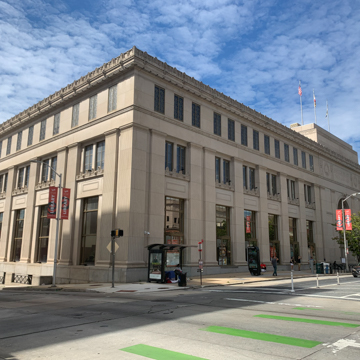In 1933 Baltimore’s new central library opened in a limestone-sheathed building decorated with stylized classical motifs. Merchant and philanthropist Enoch Pratt established the city’s free library system in 1882 with four neighborhood branches and the first central building designed by Charles L. Carson (1886; demolished). Not only was the new central building larger and more fashionable, but it benefited from the expertise of Edward Tilton, a New York City architect who made a specialty of library design during the early twentieth century.
Like the Carnegie-funded libraries proliferating nationally, Baltimore’s library system embraced Progressive library design and operations, including an open floor plan and open stacks for lending collections available to all residents. The street-level entrance and display windows along Cathedral Street recalled a department store welcoming all patrons inside to browse. The Children’s Room entrance on Mulberry Street signaled a new commitment to serving young readers. Following the terms of Pratt’s bequest, the library system was one of the few public institutions in the city available to all, regardless of race. The library reopened in 2020 after a major renovation that included sensitive restoration of its elegant Art Deco features.













